The Research
Is there research on 4-year-old birthday parties? Why yes, there is! Why, you ask? Because anything that causes adults and children alike a great deal of stress and discontent (and, sure, joy too) is worth studying.
When “researching” what the heck to do for my child’s pandemic-era fourth birthday party earlier this month, I turned to my favorite (and, not unrelatedly, shortest) parenting book collection: the Your ___-Year-Old series by Louise Bates Ames and Frances L. Ilg. I already owned and enjoyed years 1-3 in the series, so I felt pretty confident that picking up a copy of Your Four-Year-Old: Wild and Wonderful, would provide some return-on-investment. Especially since it contains an entire chapter on birthday parties.
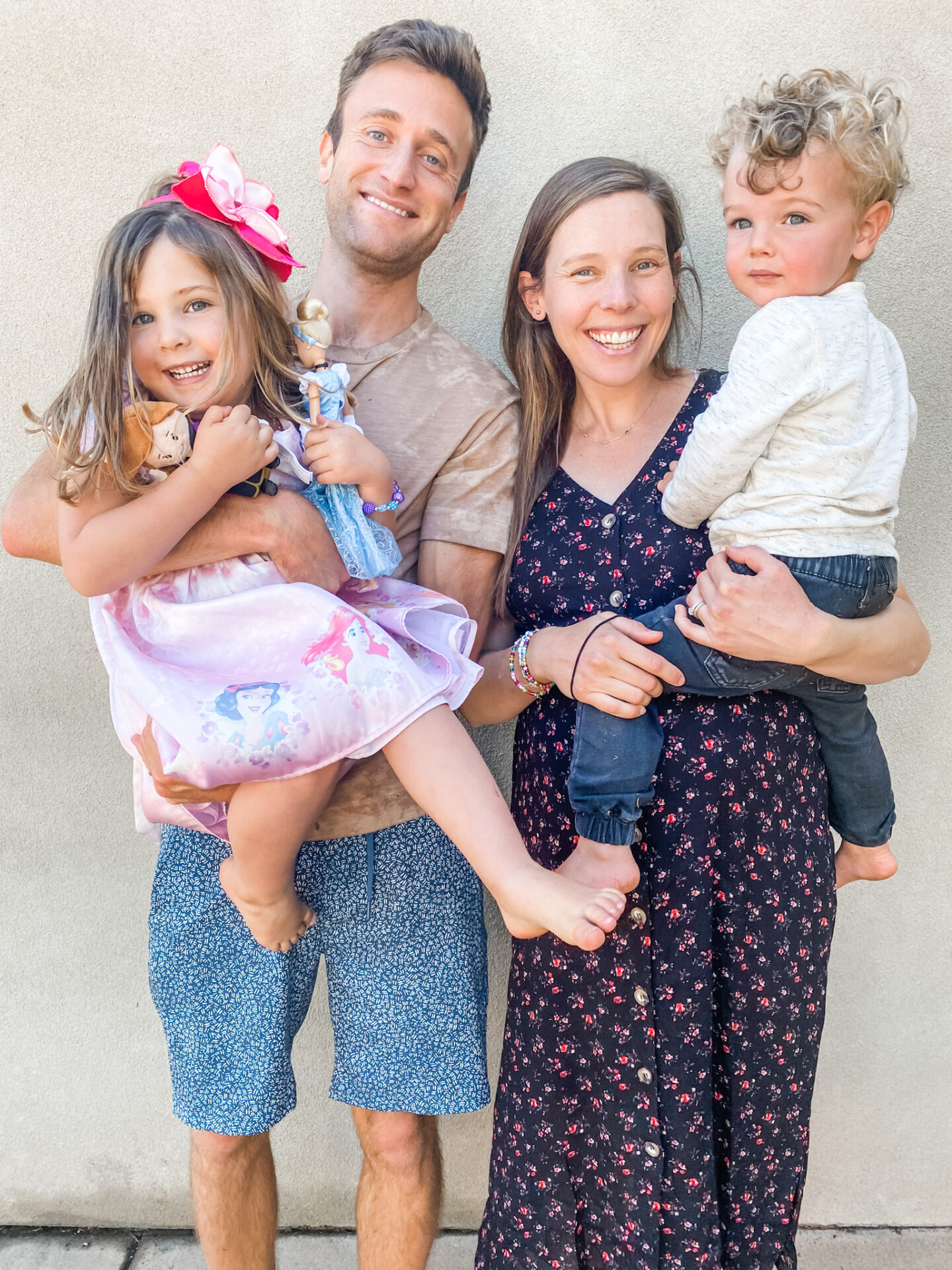
While a single party may seem insignificant in the scheme of an entire year of child development (why even write a chapter on it?), birthdays are formative experiences for kids, and I found the information provided both enlightening and reassuring (spoiler alert: you don’t have to hire the clown and the balloon artist).
Before I go on, I’m not here to criticize an over-the-top birthday party. I enjoy a good champagne-fueled, backyard petting zoo as much as the next person. But putting those kinds of events together takes a lot of work, as well as a level of energy that I just don’t have most days. Plus, we’re still living in the midst of a pandemic, and the less people (and livestock) I invite into my backyard these days, the better.
Thankfully, Ames and Ilg assert that a small, simple, and short party is what’s most developmentally appropriate for most four-year-olds. First, they suggest an ideal number of guests of around 6-8 kids, and a preferred time frame of about an hour and a half. The limited number of guests prevents social anxiety or overwhelm (for the kids and adults…), and the time frame gives kids enough time to eat, play, open presents, and leave without totally destroying the house. Additionally, it ensures that most kids leave before reaching the point of exhaustion, over-stimulation (or, God forbid, both).
Ames also suggests that you keep games and activities as simple as possible. Kids will already be distracted by their friends and new environment, and won’t be able to attend to too many rules or steps. And while four-year-olds are much more competent inter-personal players than twos and threes, they still struggle with extended, adult-directed group play, and would oftentimes rather engage in an activity alone, but in the proximity of their friends.
Lastly, Ames suggests giving kids plenty of time to “free play.” I think that parents (including myself) often feel like we have to plan out every minute of a party, lest the kids get “bored” and turn on us, but this really isn’t true. Four-year-olds especially are incredibly creative, imaginative, and self-directed, and usually appreciate being able to make their own decisions about how they interact with a new environment.
The Book! (Affiliate Link):

The Ideal, Non-Pandemic Birthday Party
Last year, when my daughter turned three, she and her best friend had a joint, Frozen-themed birthday party at the local JCC. We were able to rent the outdoor, fully-fenced playground for a few hours in the late morning, and even hired a very convincing Elsa impersonator.
For the first 30-40 minutes of the party, the kids played on the playground. They were thrilled to have the equipment to themselves, and played in a pretty self-directed manner for most of that time. Then, “Elsa” arrived, and the “planned” festivities began.
“Real Elsa” was, admittedly, kind of expensive, but I think that a parent could easily have played the same role (minus the full costume and makeup). Essentially, Elsa came in (to many a scream of delight and awe), told the kids the story of Frozen, and sang a few songs with them. There was a photo-op, and then she was done (because 3 and 4-year-olds can only sit still–even for Elsa–for so long).

Elsa-time was followed by cake, snacks, the handing out of party favors (books of course) and a quick goodbye. It was simple, but active enough that the kids left happy, tired and ready for a nap. If I could have done the exact same party this year, I would have; it was that big of a hit, and that little planning or mess for me. It also happened to check most of the boxes Ames and Ilg set out for the ideal, developmentally-appropriate, little-kid birthday party.
The Just-As-Great Pandemic Party
This year, with the pandemic still in full swing, it didn’t feel safe, or responsible to invite a bunch of kids to a public playground for shared snacks and drinks. So, we stuck with a few trusted friends from our preschool pod, and tried our best to recreate the experience in our backyard. This year’s theme (chosen by the birthday girl, of course) was “Princess Party.”
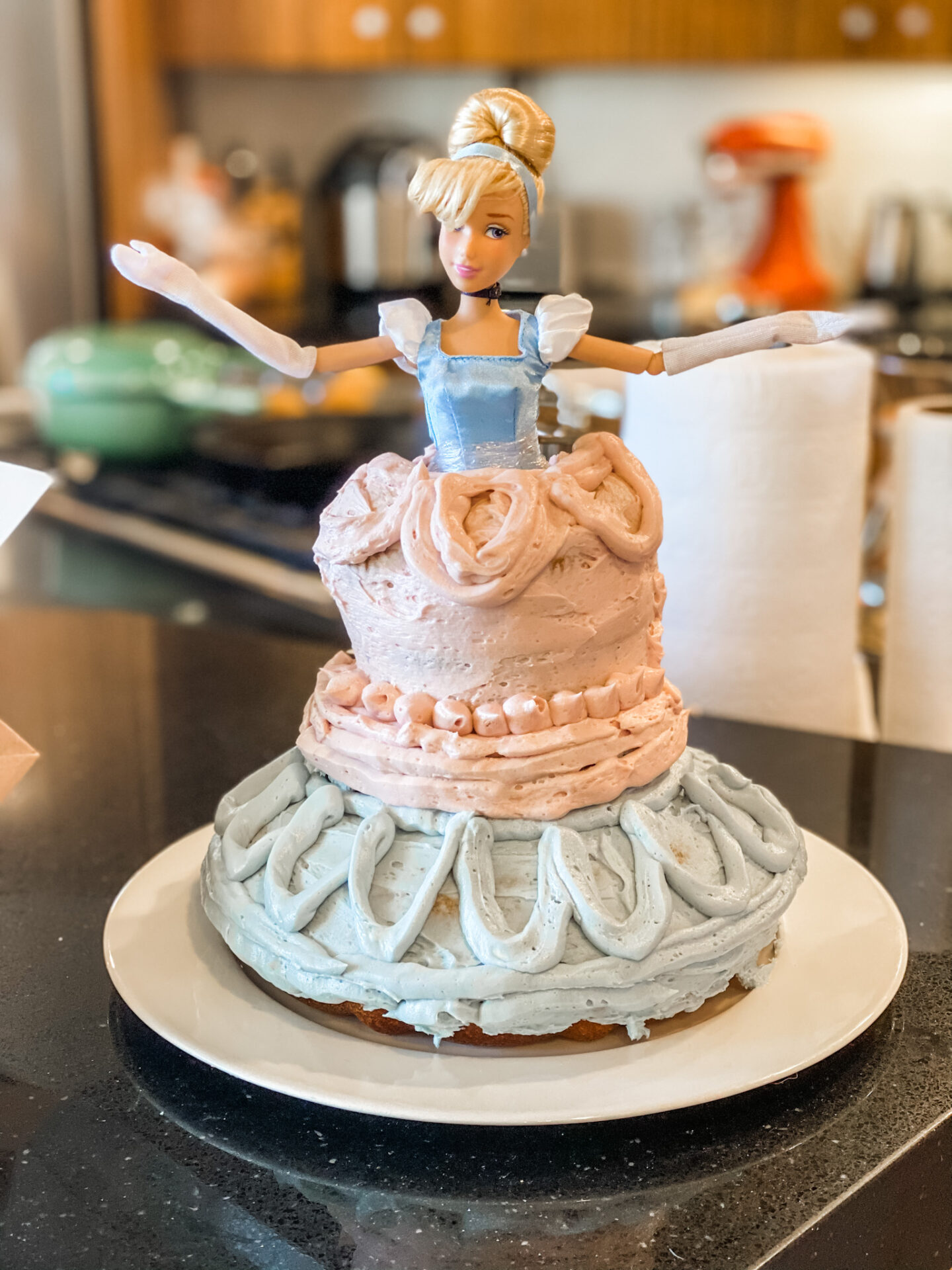
We have a total of three families in the pod, each with two children, so the number of guests actually worked out to be exactly what Ames and Ilg recommend. When the kids arrived, they all headed out to the backyard to play on the climbing structure and playhouse. While we’ve had these two structures in the yard for over a year now, they are practically invisible to my children until a non-family member shows some kind of interest in them.
After a brief self-directed play period, I whipped out a quick craft for the big kids. I found these Melissa and Doug Magic Wands on Amazon, and since my daughter currently believes that all princesses also have magical powers, I thought they would be appreciated. The girls all seemed to enjoy painting and decorating the wands (which they also got to take home as a sort of “favor” at the end of the party). After crafting, and, admittedly, consuming a taste or two of non-toxic paint, the kids went off for more free play, followed by a stab at the “punch pinata.”
The punch pinata was an idea I got from a very creative teacher-friend after Margot requested a real pinata about a week or so before her party. While I’m definitely a fan of pinatas, I think they can be tough for little kids, as someone always feels slighted, either during the hitting, or the collecting of toys and candy. I’ll include the full directions for how to make a punch pinata below, but it’s basically just a poster-board containing several tissue-paper-covered holes, which kids can “punch” through and grab a toy or treat. This type of pinata is great for little kids, as it allows everyone to have a turn, and come away with a similar prize.
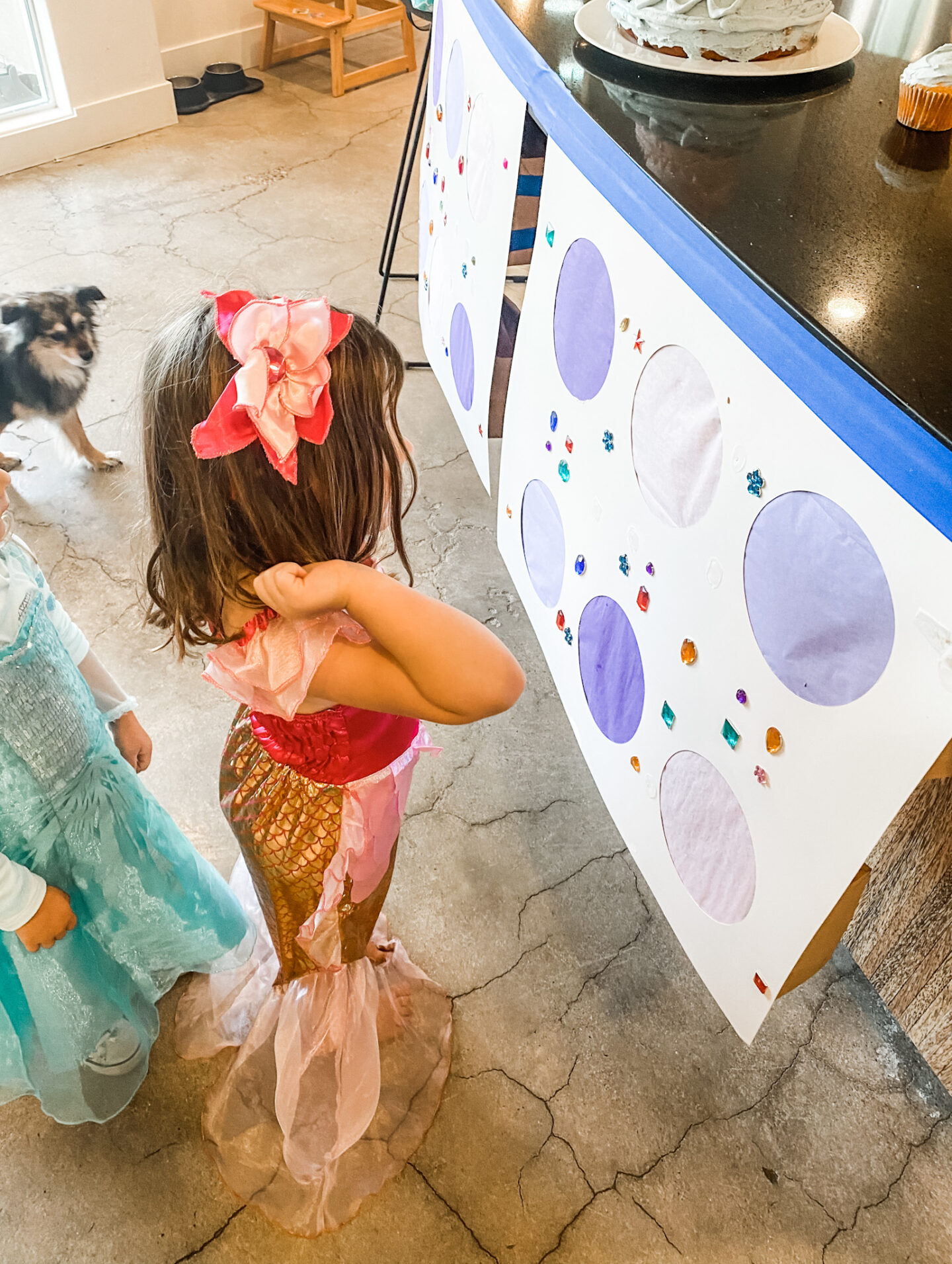
After pinata time, the kids ate pizza, sang happy birthday, ate cake, and got ready to go home. While the party was super simple, my daughter was totally thrilled by it. She loved being the center of attention, but wasn’t overstimulated by too many people doting on her. While she did receive some special presents, her friends also walked away with some fun stuff too, which helped curb the jealousy that is pretty typical at this age.
And, equally as importantly, my husband and I went to bed at night only slightly more tired than usual, with a clean house, and satisfied, sleepy kids.
So, if you’re feeling stressed about planning the “perfect” party for your soon-to-be four-year-old (or any “year-old” for that matter), cut yourself some slack. The “perfect” party doesn’t have to be elaborate and exhausting. In fact, your kid (and YOU) might enjoy it even more if you stress less, and set the kids up to mostly entertain themselves.
If you found this helpful, let me know in the comments! And for more pics of the party-planning process, and the final result, you can follow me on Instagram @thepaperdart.
DIY Punch Pinata Details
A Pinata that does not require glue, or tears, and that’s easy enough for your husband to finish making while you panic-frost the cake 10 minutes before your guests arrive?! I’m sold. Here are the steps:
- Cut six, evenly-spaced out circles into a piece of poster-board. I didn’t bother to measure the spacing, and it turned out fine. I also invested in this handy-dandy circle cutter to get the job done in a slightly more professional manner. (Word of warning, the circle cutter does leave little punch marks in the poster board outside of the circles (that’s what my lovely, “princess jewels” are covering up…).
- Cover each hole (from the back of the poster board) with tissue paper. I used three layers of paper over each hole to make it opaque enough that the kids couldn’t see the prize inside. Tape the tissue paper securely on all edges.
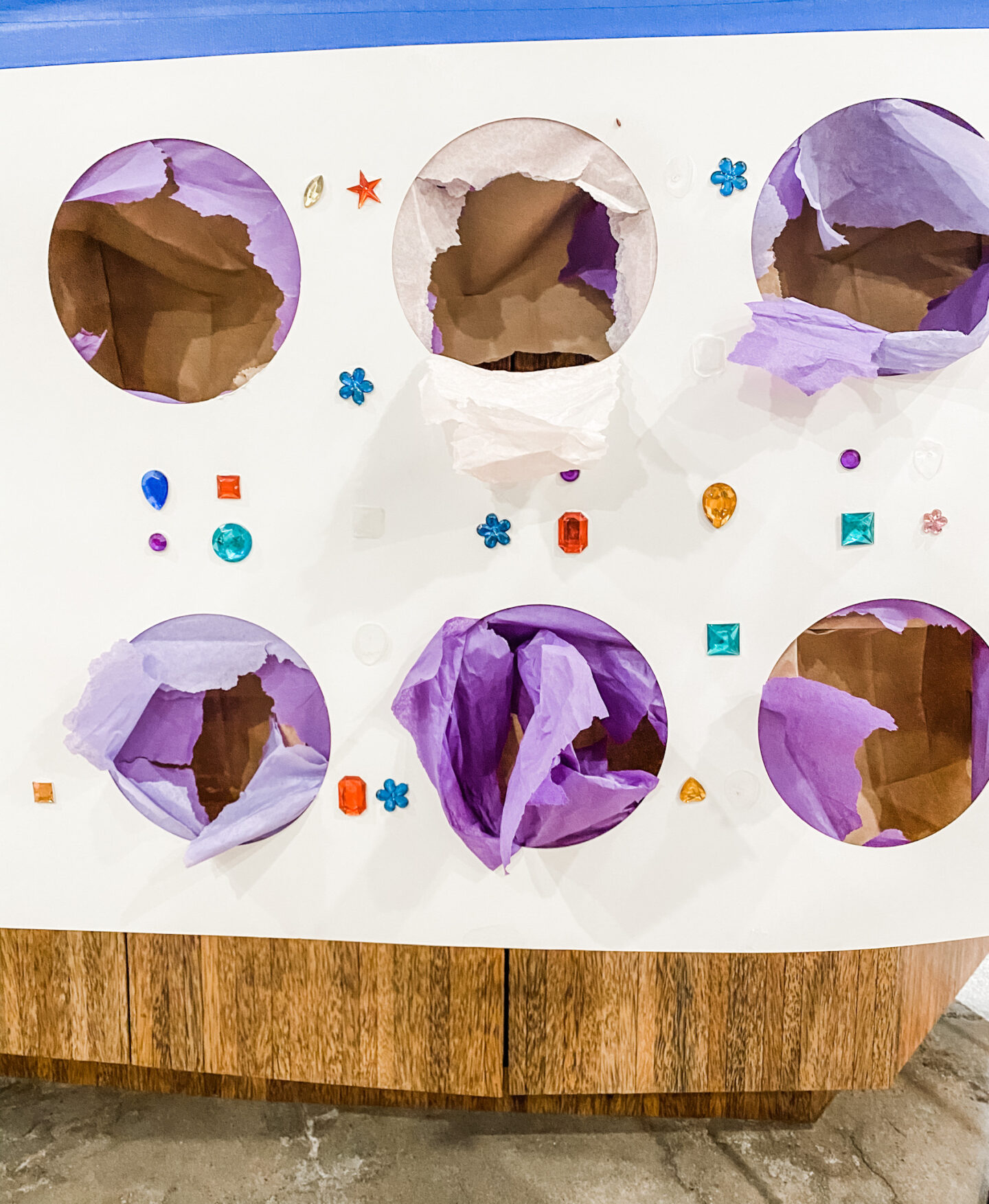
3. Place a toy or prize on top of the tissue paper (again, on the back of the poster board). You’ll want to pick prizes that aren’t too heavy, or they may fall out of the bag before the kids can get to them.
4. Open a paper lunch bag and cut it, length-wise and down the middle, to the bottom of the bag. Then, cut along one side of the bottom, and splay the sides of the bag open. Tape the open side of the paper bag to the poster board so that it covers the toy, and the entirety of the tissue-paper-covered hole. Do your best to tuck in the top of the bag and get it taped down as securely as possible. You will want the bag to be able to hold the weight of the toy/prize even when the board is hanging up by it’s side. (My tape job looked pretty sloppy, but it doesn’t really matter, as no one will be looking at the back).
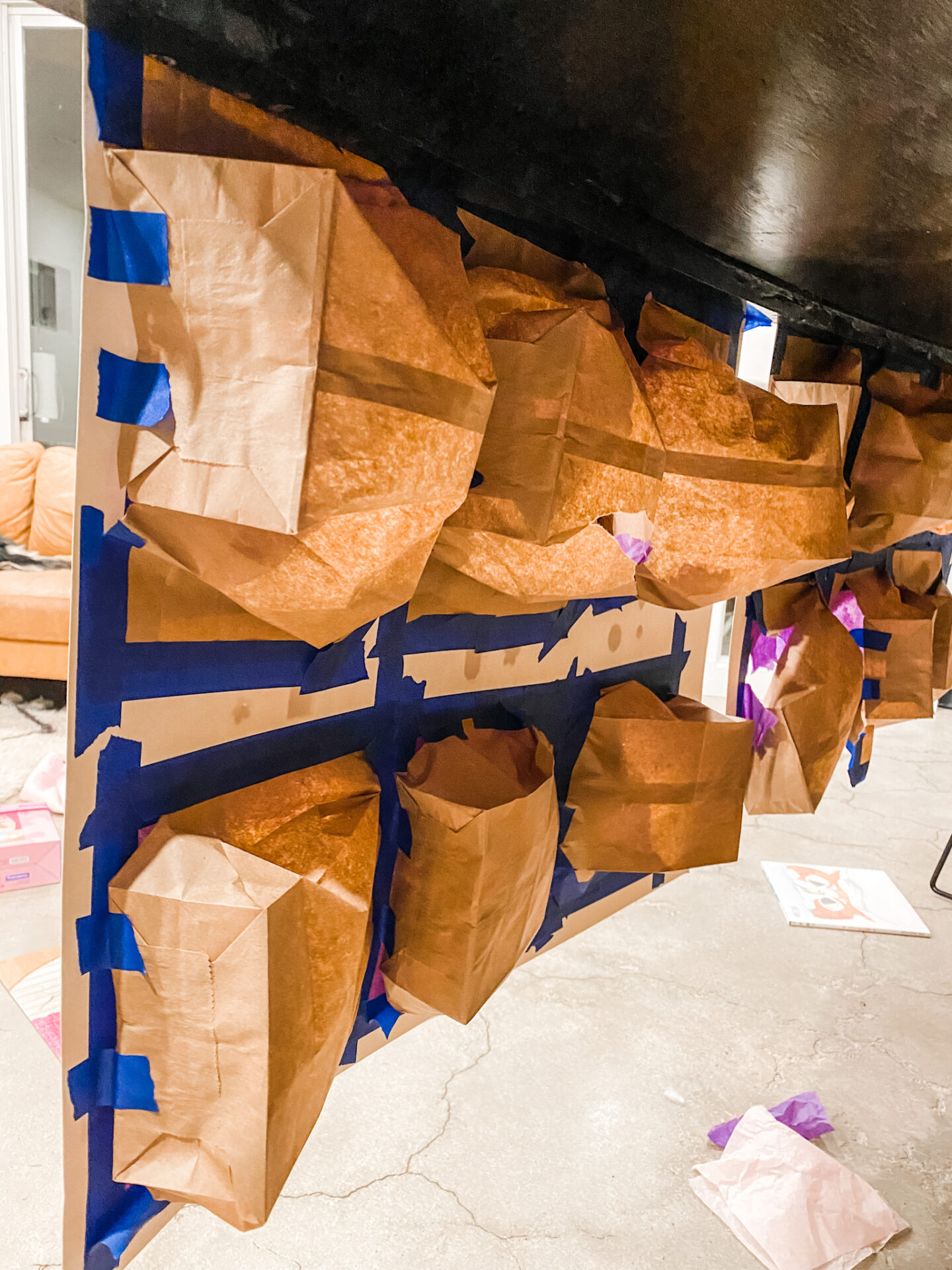
5. Hang the poster board up on some kind of ledge (ours is hanging off our kitchen bar counter). You could also run a string along the top of the board and hang it from a branch or tree.
6. Line those kiddos up and give each one a turn punching in a hole and grabbing out a prize!